

How to Write a Biography
Biographies are big business. Whether in book form or Hollywood biopics, the lives of the famous and sometimes not-so-famous fascinate us.
While it’s true that most biographies are about people who are in the public eye, sometimes the subject is less well-known. Primarily, though, famous or not, the person who is written about has led an incredible life.
In this article, we will explain biography writing in detail for teachers and students so they can create their own.
While your students will most likely have a basic understanding of a biography, it’s worth taking a little time before they put pen to paper to tease out a crystal-clear definition of one.

What Is a Biography?

A biography is an account of someone’s life written by someone else . While there is a genre known as a fictional biography, for the most part, biographies are, by definition, nonfiction.
Generally speaking, biographies provide an account of the subject’s life from the earliest days of childhood to the present day or, if the subject is deceased, their death.
The job of a biography is more than just to outline the bare facts of a person’s life.
Rather than just listing the basic details of their upbringing, hobbies, education, work, relationships, and death, a well-written biography should also paint a picture of the subject’s personality and experience of life.

Full Biographies
Teaching unit.
Teach your students everything they need to know about writing an AUTOBIOGRAPHY and a BIOGRAPHY.
⭐⭐⭐⭐⭐ ( 26 reviews )
Features of a Biography
Before students begin writing a biography, they’ll need to have a firm grasp of the main features of a Biography. An excellent way to determine how well they understand these essential elements is to ask them to compile a checklist like the one-blow
Their checklists should contain the items below at a minimum. Be sure to help them fill in any gaps before moving on to the writing process.
The purpose of a biography is to provide an account of someone’s life.
Biography structure.
ORIENTATION (BEGINNING) Open your biography with a strong hook to grab the reader’s attention
SEQUENCING: In most cases, biographies are written in chronological order unless you are a very competent writer consciously trying to break from this trend.
COVER: childhood, upbringing, education, influences, accomplishments, relationships, etc. – everything that helps the reader to understand the person.
CONCLUSION: Wrap your biography up with some details about what the subject is doing now if they are still alive. If they have passed away, make mention of what impact they have made and what their legacy is or will be.
BIOGRAPHY FEATURES
LANGUAGE Use descriptive and figurative language that will paint images inside your audience’s minds as they read. Use time connectives to link events.
PERSPECTIVE Biographies are written from the third person’s perspective.
DETAILS: Give specific details about people, places, events, times, dates, etc. Reflect on how events shaped the subject. You might want to include some relevant photographs with captions. A timeline may also be of use depending upon your subject and what you are trying to convey to your audience.
TENSE Written in the past tense (though ending may shift to the present/future tense)
THE PROCESS OF WRITING A BIOGRAPHY
Like any form of writing, you will find it simple if you have a plan and follow it through. These steps will ensure you cover the essential bases of writing a biography essay.
Firstly, select a subject that inspires you. Someone whose life story resonates with you and whose contribution to society intrigues you. The next step is to conduct thorough research. Engage in extensive reading, explore various sources, watch documentaries, and glean all available information to provide a comprehensive account of the person’s life.
Creating an outline is essential to organize your thoughts and information. The outline should include the person’s early life, education, career, achievements, and any other significant events or contributions. It serves as a map for the writing process, ensuring that all vital information is included.
Your biography should have an engaging introduction that captivates the reader’s attention and provides background information on the person you’re writing about. It should include a thesis statement summarising the biography’s main points.
Writing a biography in chronological order is crucial . You should begin with the person’s early life and move through their career and achievements. This approach clarifies how the person’s life unfolded and how they accomplished their goals.
A biography should be written in a narrative style , capturing the essence of the person’s life through vivid descriptions, anecdotes, and quotes. Avoid dry, factual writing and focus on creating a compelling narrative that engages the reader.
Adding personal insights and opinions can enhance the biography’s overall impact, providing a unique perspective on the person’s achievements, legacy, and impact on society.
Editing and proofreading are vital elements of the writing process. Thoroughly reviewing your biography ensures that the writing is clear, concise, and error-free. You can even request feedback from someone else to ensure that it is engaging and well-written.
Finally, including a bibliography at the end of your biography is essential. It gives credit to the sources that were used during research, such as books, articles, interviews, and websites.
Tips for Writing a Brilliant Biography
Biography writing tip #1: choose your subject wisely.
There are several points for students to reflect on when deciding on a subject for their biography. Let’s take a look at the most essential points to consider when deciding on the subject for a biography:
Interest: To produce a biography will require sustained writing from the student. That’s why students must choose their subject well. After all, a biography is an account of someone’s entire life to date. Students must ensure they choose a subject that will sustain their interest throughout the research, writing, and editing processes.
Merit: Closely related to the previous point, students must consider whether the subject merits the reader’s interest. Aside from pure labors of love, writing should be undertaken with the reader in mind. While producing a biography demands sustained writing from the author, it also demands sustained reading from the reader.
Therefore, students should ask themselves if their chosen subject has had a life worthy of the reader’s interest and the time they’d need to invest in reading their biography.
Information: Is there enough information available on the subject to fuel the writing of an entire biography? While it might be a tempting idea to write about a great-great-grandfather’s experience in the war. There would be enough interest there to sustain the author’s and the reader’s interest, but do you have enough access to information about their early childhood to do the subject justice in the form of a biography?
Biography Writing Tip #2: R esearch ! Research! Research!
While the chances are good that the student already knows quite a bit about the subject they’ve chosen. Chances are 100% that they’ll still need to undertake considerable research to write their biography.
As with many types of writing , research is an essential part of the planning process that shouldn’t be overlooked. If students wish to give as complete an account of their subject’s life as possible, they’ll need to put in the time at the research stage.
An effective way to approach the research process is to:
1. Compile a chronological timeline of the central facts, dates, and events of the subject’s life
2. Compile detailed descriptions of the following personal traits:
- Physical looks
- Character traits
- Values and beliefs
3. Compile some research questions based on different topics to provide a focus for the research:
- Childhood : Where and when were they born? Who were their parents? Who were the other family members? What education did they receive?
- Obstacles: What challenges did they have to overcome? How did these challenges shape them as individuals?
- Legacy: What impact did this person have on the world and/or the people around them?
- Dialogue & Quotes: Dialogue and quotations by and about the subject are a great way to bring color and life to a biography. Students should keep an eagle eye out for the gems that hide amid their sources.
As the student gets deeper into their research, new questions will arise that can further fuel the research process and help to shape the direction the biography will ultimately go in.
Likewise, during the research, themes will often begin to suggest themselves. Exploring these themes is essential to bring depth to biography, but we’ll discuss this later in this article.
Research Skills:
Researching for biography writing is an excellent way for students to hone their research skills in general. Developing good research skills is essential for future academic success. Students will have opportunities to learn how to:
- Gather relevant information
- Evaluate different information sources
- Select suitable information
- Organize information into a text.
Students will have access to print and online information sources, and, in some cases, they may also have access to people who knew or know the subject (e.g. biography of a family member).
These days, much of the research will likely take place online. It’s crucial, therefore, to provide your students with guidance on how to use the internet safely and evaluate online sources for reliability. This is the era of ‘ fake news ’ and misinformation after all!
COMPLETE TEACHING UNIT ON INTERNET RESEARCH SKILLS USING GOOGLE SEARCH

Teach your students ESSENTIAL SKILLS OF THE INFORMATION ERA to become expert DIGITAL RESEARCHERS.
⭐How to correctly ask questions to search engines on all devices.
⭐ How to filter and refine your results to find exactly what you want every time.
⭐ Essential Research and critical thinking skills for students.
⭐ Plagiarism, Citing and acknowledging other people’s work.
⭐ How to query, synthesize and record your findings logically.
BIOGRAPHY WRITING Tip #3: Find Your Themes In Biography Writing
Though predominantly a nonfiction genre, the story still plays a significant role in good biography writing. The skills of characterization and plot structuring are transferable here. And, just like in fiction, exploring themes in a biographical work helps connect the personal to the universal. Of course, these shouldn’t be forced; this will make the work seem contrived, and the reader may lose faith in the truthfulness of the account. A biographer needs to gain and maintain the trust of the reader.
Fortunately, themes shouldn’t need to be forced. A life well-lived is full of meaning, and the themes the student writer is looking for will emerge effortlessly from the actions and events of the subject’s life. It’s just a case of learning how to spot them.
One way to identify the themes in a life is to look for recurring events or situations in a person’s life. These should be apparent from the research completed previously. The students should seek to identify these patterns that emerge in the subject’s life. For example, perhaps they’ve had to overcome various obstacles throughout different periods of their life. In that case, the theme of overcoming adversity is present and has been identified.
Usually, a biography has several themes running throughout, so be sure your students work to identify more than one theme in their subject’s life.
BIOGRAPHY WRITING Tip: #4 Put Something of Yourself into the Writing
While the defining feature of a biography is that it gives an account of a person’s life, students must understand that this is not all a biography does. Relating the facts and details of a subject’s life is not enough. The student biographer should not be afraid to share their thoughts and feelings with the reader throughout their account of their subject’s life.
The student can weave some of their personality into the fabric of the text by providing commentary and opinion as they relate the events of the person’s life and the wider social context at the time. Unlike the detached and objective approach we’d expect to find in a history textbook, in a biography, student-writers should communicate their enthusiasm for their subject in their writing.
This makes for a more intimate experience for the reader, as they get a sense of getting to know the author and the subject they are writing about.
Biography Examples For Students
- Year 5 Example
- Year 7 Example
- Year 9 Example
“The Rock ‘n’ Roll King: Elvis Presley”
Elvis Aaron Presley, born on January 8, 1935, was an amazing singer and actor known as the “King of Rock ‘n’ Roll.” Even though he’s been dead for nearly 50 years, I can’t help but be fascinated by his incredible life!
Elvis grew up in Tupelo, Mississippi, in a tiny house with his parents and twin brother. His family didn’t have much money, but they shared a love for music. Little did they know Elvis would become a music legend!
When he was only 11 years old, Elvis got his first guitar. He taught himself to play and loved singing gospel songs. As he got older, he started combining different music styles like country, blues, and gospel to create a whole new sound – that’s Rock ‘n’ Roll!
In 1954, at the age of 19, Elvis recorded his first song, “That’s All Right.” People couldn’t believe how unique and exciting his music was. His famous hip-swinging dance moves also made him a sensation!
Elvis didn’t just rock the music scene; he also starred in movies like “Love Me Tender” and “Jailhouse Rock.” But fame came with challenges. Despite facing ups and downs, Elvis kept spreading happiness through his music.

Tragically, Elvis passed away in 1977, but his music and charisma live on. Even today, people worldwide still enjoy his songs like “Hound Dog” and “Can’t Help Falling in Love.” Elvis Presley’s legacy as the King of Rock ‘n’ Roll will live forever.
Long Live the King: I wish I’d seen him.
Elvis Presley, the Rock ‘n’ Roll legend born on January 8, 1935, is a captivating figure that even a modern-day teen like me can’t help but admire. As I delve into his life, I wish I could have experienced the magic of his live performances.
Growing up in Tupelo, Mississippi, Elvis faced challenges but found solace in music. At 11, he got his first guitar, a symbol of his journey into the world of sound. His fusion of gospel, country, and blues into Rock ‘n’ Roll became a cultural phenomenon.
The thought of being in the audience during his early performances, especially when he recorded “That’s All Right” at 19, sends shivers down my spine. Imagining the crowd’s uproar and feeling the revolutionary energy of that moment is a dream I wish I could have lived.
Elvis wasn’t just a musical prodigy; he was a dynamic performer. His dance moves, the embodiment of rebellion, and his roles in films like “Love Me Tender” and “Jailhouse Rock” made him a true icon.
After watching him on YouTube, I can’t help but feel a little sad that I’ll never witness the King’s live performances. The idea of swaying to “Hound Dog” or being enchanted by “Can’t Help Falling in Love” in person is a missed opportunity. Elvis may have left us in 1977, but he was the king of rock n’ roll. Long live the King!
Elvis Presley: A Teen’s Take on the Rock ‘n’ Roll Icon”
Elvis Presley, born January 8, 1935, was a revolutionary force in the music world, earning his title as the “King of Rock ‘n’ Roll.” Exploring his life, even as a 16-year-old today, I’m captivated by the impact he made.
Hailing from Tupelo, Mississippi, Elvis grew up in humble beginnings, surrounded by the love of his parents and twin brother. It’s inspiring to think that, despite financial challenges, this young man would redefine the music scene.
At 11, Elvis got his first guitar, sparking a self-taught journey into music. His early gospel influences evolved into a unique fusion of country, blues, and gospel, creating the electrifying genre of Rock ‘n’ Roll. In 1954, at only 19, he recorded “That’s All Right,” marking the birth of a musical legend.
Elvis wasn’t just a musical innovator; he was a cultural phenomenon. His rebellious dance moves and magnetic stage presence challenged the norms. He transitioned seamlessly into acting, starring in iconic films like “Love Me Tender” and “Jailhouse Rock.”

However, fame came at a cost, and Elvis faced personal struggles. Despite the challenges, his music continued to resonate. Even now, classics like “Hound Dog” and “Can’t Help Falling in Love” transcend generations.
Elvis Presley’s impact on music and culture is undeniable. He was known for his unique voice, charismatic persona, and electrifying performances. He sold over one billion records worldwide, making him one of the best-selling solo artists in history. He received numerous awards throughout his career, including three Grammy Awards and the Grammy Lifetime Achievement Award.
Elvis’s influence can still be seen in today’s music. Many contemporary artists, such as Bruno Mars, Lady Gaga, and Justin Timberlake, have cited Elvis as an inspiration. His music continues to be featured in movies, TV shows, and commercials.
Elvis left us in 1977, but his legacy lives on. I appreciate his breaking barriers and fearlessly embracing his artistic vision. Elvis Presley’s impact on music and culture is timeless, a testament to the enduring power of his artistry. His music has inspired generations and will continue to do so for many years to come.

Teaching Resources
Use our resources and tools to improve your student’s writing skills through proven teaching strategies.
BIOGRAPHY WRITING TEACHING IDEAS AND LESSONS
We have compiled a sequence of biography-related lessons or teaching ideas that you can follow as you please. They are straightforward enough for most students to follow without further instruction.
BIOGRAPHY LESSON IDEA # 1:
This session aims to give students a broader understanding of what makes a good biography.
Once your students have compiled a comprehensive checklist of the main features of a biography, allow them to use it to assess some biographies from your school library or on the internet using the feature checklist.
When students have assessed a selection of biographies, take some time as a class to discuss them. You can base the discussion around the following prompts:
- Which biographies covered all the criteria from their checklist?
- Which biographies didn’t?
- Which biography was the most readable in terms of structure?
- Which biography do you think was the least well-structured? How would you improve this?
Looking at how other writers have interpreted the form will help students internalize the necessary criteria before attempting to produce a biography. Once students have a clear understanding of the main features of the biography, they’re ready to begin work on writing a biography.
When the time does come to put pen to paper, be sure they’re armed with the following top tips to help ensure they’re as well prepared as possible.
BIOGRAPHY LESSON IDEA # 2:
This session aims to guide students through the process of selecting the perfect biography subject.
Instruct students to draw up a shortlist of three potential subjects for the biography they’ll write.
Using the three criteria mentioned in the writing guide (Interest, Merit, and Information), students award each potential subject a mark out of 5 for each of the criteria. In this manner, students can select the most suitable subject for their biography.
BIOGRAPHY LESSON IDEA # 3:
This session aims to get students into the researching phase, then prioritise and organise events chronologically.
Students begin by making a timeline of their subject’s life, starting with their birth and ending with their death or the present day. If the student has yet to make a final decision on the subject of their biography, a family member will often serve well for this exercise as a practice exercise.
Students should research and gather the key events of the person’s life, covering each period of their life from when they were a baby, through childhood and adolescence, right up to adulthood and old age. They should then organize these onto a timeline. Students can include photographs with captions if they have them.
They can present these to the class when they have finished their timelines.
BIOGRAPHY LESSON IDEA # 4:
Instruct students to look over their timeline, notes, and other research. Challenge them to identify three patterns that repeat throughout the subject’s life and sort all the related events and incidents into specific categories.
Students should then label each category with a single word. This is the thematic concept or the broad general underlying idea. After that, students should write a sentence or two expressing what the subject’s life ‘says’ about that concept.
This is known as the thematic statement . With the thematic concepts and thematic statements identified, the student now has some substantial ideas to explore that will help bring more profound meaning and wider resonance to their biography.
BIOGRAPHY LESSON IDEA # 5:
Instruct students to write a short objective account of an event in their own life. They can write about anyone from their past. It needn’t be more than a couple of paragraphs, but the writing should be strictly factual, focusing only on the objective details of what happened.
Once they have completed this, it’s time to rewrite the paragraph, but they should include some opinion and personal commentary this time.
The student here aims to inject some color and personality into their writing, to transform a detached, factual account into a warm, engaging story.
A COMPLETE UNIT ON TEACHING BIOGRAPHIES

Teach your students to write AMAZING BIOGRAPHIES & AUTOBIOGRAPHIES using proven RESEARCH SKILLS and WRITING STRATEGIES .
- Understand the purpose of both forms of biography.
- Explore the language and perspective of both.
- Prompts and Challenges to engage students in writing a biography.
- Dedicated lessons for both forms of biography.
- Biographical Projects can expand students’ understanding of reading and writing a biography.
- A COMPLETE 82-PAGE UNIT – NO PREPARATION REQUIRED.

FREE Biography Writing Graphic Organizer
Use this valuable tool in the research and writing phases to keep your students on track and engaged.
WRITING CHECKLIST & RUBRIC BUNDLE

⭐⭐⭐⭐⭐ (92 Reviews)
To Conclude
By this stage, your students should have an excellent technical overview of a biography’s essential elements.
They should be able to choose their subject in light of how interesting and worthy they are, as well as give consideration to the availability of information out there. They should be able to research effectively and identify emerging themes in their research notes. And finally, they should be able to bring some of their personality and uniqueness into their retelling of the life of another.
Remember that writing a biography is not only a great way to develop a student’s writing skills; it can be used in almost all curriculum areas. For example, to find out more about a historical figure in History, to investigate scientific contributions to Science, or to celebrate a hero from everyday life.
Biography is an excellent genre for students to develop their writing skills and to find inspiration in the lives of others in the world around them.
HOW TO WRITE A BIOGRAPHY TUTORIAL VIDEO

OTHER GREAT ARTICLES RELATED TO BIOGRAPHY WRITING

How to write an Autobiography

How to Write a Historical Recount Text

15 Awesome Recount & Personal Narrative Topics

Personal Narrative Writing Guide
- PRO Courses Guides New Tech Help Pro Expert Videos About wikiHow Pro Upgrade Sign In
- EDIT Edit this Article
- EXPLORE Tech Help Pro About Us Random Article Quizzes Request a New Article Community Dashboard This Or That Game Happiness Hub Popular Categories Arts and Entertainment Artwork Books Movies Computers and Electronics Computers Phone Skills Technology Hacks Health Men's Health Mental Health Women's Health Relationships Dating Love Relationship Issues Hobbies and Crafts Crafts Drawing Games Education & Communication Communication Skills Personal Development Studying Personal Care and Style Fashion Hair Care Personal Hygiene Youth Personal Care School Stuff Dating All Categories Arts and Entertainment Finance and Business Home and Garden Relationship Quizzes Cars & Other Vehicles Food and Entertaining Personal Care and Style Sports and Fitness Computers and Electronics Health Pets and Animals Travel Education & Communication Hobbies and Crafts Philosophy and Religion Work World Family Life Holidays and Traditions Relationships Youth
- Browse Articles
- Learn Something New
- Quizzes Hot
- Happiness Hub
- This Or That Game
- Train Your Brain
- Explore More
- Support wikiHow
- About wikiHow
- Log in / Sign up
- Education and Communications
How to Write a Biography
Last Updated: May 28, 2024 Fact Checked
This article was co-authored by Stephanie Wong Ken, MFA . Stephanie Wong Ken is a writer based in Canada. Stephanie's writing has appeared in Joyland, Catapult, Pithead Chapel, Cosmonaut's Avenue, and other publications. She holds an MFA in Fiction and Creative Writing from Portland State University. This article has been fact-checked, ensuring the accuracy of any cited facts and confirming the authority of its sources. This article has been viewed 1,878,522 times.
Writing a biography can be a fun challenge, where you are sharing the story of someone’s life with readers. You may need to write a biography for a class or decide to write one as a personal project. Once you have identified the subject of the biography, do your research so you know as much about them as possible. Then, dive into the writing of the biography and revising it until it is at its finest.
Researching Your Subject

- If the subject does not give you permission to write the biography, you may want to choose a different subject. If you decide to publish the biography without the subject’s permission, you may be susceptible to legal action by the subject.
- If the subject is no longer alive, you obviously do not need to ask permission to write about them.

- You may create research questions to help focus your research of the subject, such as, What do I find interesting about the subject? Why is this subject important to readers? What can I say that is new about the subject? What would I like to learn more about?

- For in person interviews, record them with a tape recorder or a voice recorder on your computer or phone.
- You may need to interview the subject and others several times to get the material you need.

- You may also want to visit areas where the subject made a major decision or breakthrough in their life. Being physically in the area can give you a sense of how the subject might have felt and help you write their experiences more effectively.

- When researching the time period ask yourself: What were the social norms of that time? What was going on economically and politically? How did the social and political climate affect the subject?

- You may also include historical events or moments that affected the subject on the timeline. For example, maybe there was a conflict or civil war that happened during the person’s life that affected their life.
Writing the Biography

- You may end up focusing on particular areas of the person’s life. If you do this, work through a particular period in the person’s life chronologically.

- For example, you may have a thesis statement about focusing on how the person impacted the civil rights movement in America in the 1970s. You can then make sure all your content relates back to this thesis.

- Flashbacks should feel as detailed and real as present day scenes. Use your research notes and interviews with the subject to get a good sense of their past for the flashbacks.
- For example, you may jump from the person’s death in the present to a flashback to their favorite childhood memory.

- For example, you may focus on the person’s accomplishments in the civil rights movement. You may write a whole section about their contributions and participation in major civil rights marches in their hometown.

- For example, you may notice that the person’s life is patterned with moments of adversity, where the person worked hard and fought against larger forces. You can then use the theme of overcoming adversity in the biography.

- For example, you may note how you see parallels in the person’s life during the civil rights movement with your own interests in social justice. You may also commend the person for their hard work and positive impact on society.
Polishing the Biography

- Revise the biography based on feedback from others. Do not be afraid to cut or edit down the biography to suit the needs of your readers.

- Having a biography riddled with spelling, grammar, and punctuation errors can turn off your readers and result in a poor grade if you are handing in the text for a class.

- If the biography is for a class, use MLA , APA , or Chicago Style citations based on the preferences of your instructor.
Biography Help

Community Q&A
- Be careful when publishing private or embarrassing information, especially if the person is not a celebrity. You may violate their "Right of Privacy" or equivalent. Thanks Helpful 31 Not Helpful 5
- Have the sources to back up your statements about the subject's life. Untruthful written statements can lead to litigation. If it is your opinion, be clear that it is such and not fact (although you can support your opinion with facts). Thanks Helpful 16 Not Helpful 15

You Might Also Like

- ↑ https://grammar.yourdictionary.com/writing/how-to-write-a-biography.html
- ↑ https://au.indeed.com/career-advice/career-development/how-to-write-a-bio
- ↑ https://www.writersdigest.com/writing-articles/3-tips-for-writing-successful-flashbacks
- ↑ https://www.grammarly.com/blog/how-to-write-bio/
- ↑ https://writingcenter.unc.edu/tips-and-tools/editing-and-proofreading/
- ↑ https://www.plagiarism.org/article/how-do-i-cite-sources
About This Article

Before you write a biography, gather as much information about the subject that you can from sources like newspaper articles, interviews, photos, existing biographies, and anything else you can find. Write the story of that person’s life, including as much supporting detail as you can, including information about the place and time where the person lived. Focus on major events and milestones in their life, including historical events, marriage, children, and events which would shape their path later in life. For tips from our reviewer on proofreading the biography and citing your sources, keep reading! Did this summary help you? Yes No
- Send fan mail to authors
Reader Success Stories
Jan 24, 2021
Did this article help you?
Janis Hendrick
Oct 10, 2018
Teresa Bradley
Sep 15, 2020
Apr 18, 2016
Latanya Foster
Apr 26, 2016

Featured Articles

Trending Articles

Watch Articles

- Terms of Use
- Privacy Policy
- Do Not Sell or Share My Info
- Not Selling Info
wikiHow Tech Help Pro:
Level up your tech skills and stay ahead of the curve
Biography Lesson Plan: An Introduction to Biographies
Submitted by: stacey lopez.
In this lesson plan which is adaptable for grades 1-5, students will use BrainPOP and/or BrainPOP Jr. resources to learn about biographies. Students will then select a person whose biography they would like to read (or watch a short video about on BrainPOP). Finally, students will write their own biography on a selected person.
Lesson Plan Common Core State Standards Alignments
Students will:.
- Define and explain what a biography is.
- Read or watch an example of a biography.
- Compose a biography.
- Computer with internet access for BrainPOP
- Interactive whiteboard (or just an LCD projector)
- Chart Paper
- Markers--variety of colors
- Sticky notes and pencils for students
- Biography template (optional)
Preparation:
Lesson procedure:.
- Explain to students that a biography of a famous person includes many facts. Ask them to take notes while they are watching either the BrainPOP Biography movie or the BrainPOP Jr. Biography movie. Explain that they will contribute to a class anchor chart about biographies.
- After the movie has finished, ask each student for a fact to add to the anchor chart. Alternate the colors to make it exciting. Students will be able to identify their contribution to the class anchor chart.
- Ask to students to read or watch a biography for a selected person in order to gather more information. Students could watch any of the BrainPOP topics in the Famous Historical Figures Unit or BrainPOP Jr. Biographies Unit , or read about the person's life in a book or online. Instruct students to take more notes while reading.
- Talk with students about the common features their biographies shared. What makes a good biography? Add to the anchor chart as needed.
- Each student may then write their own biography of another person using some of the facts that the class gathered.

- BrainPOP Jr. (K-3)
- BrainPOP ELL
- BrainPOP Science
- BrainPOP Español
- BrainPOP Français
- Set Up Accounts
- Single Sign-on
- Manage Subscription
- Quick Tours
- About BrainPOP

- Terms of Use
- Privacy Policy
- Trademarks & Copyrights
The Joy of Teaching
Sharing creative ideas and lessons to help children learn.

6 Steps to Teach Students How to Write a Biography
February 8, 2024 by Evan-Moor | 0 comments

Biographies are a key genre in storytelling. We wouldn’t know as much about Albert Einstein, Maya Angelou, Abraham Lincoln, or Mother Teresa if it weren’t for biographies! Even in our day-to-day lives, we share biographies when talking about other people, famous or not. A biography gives important information about a person’s life and describes major events in the order in which they happened.
Informational Writing and Biographies
Reading biographies is a critical part of learning in all school subjects; however, learning how to write biographies is just as imperative. Biographies are a type of informational writing or writing that aims to explain a topic to a reader. An informational text is not always about a person like a biography; an informational text might be about animals, science experiments, or historical events. Learning how to do informational writing is special, as kids can then effectively communicate what they learn to others. When studying informational writing, children learn skills such as research, note-taking, and organizing facts. More specifically, writing biographies teaches children how to recount history, think chronologically, identify major events, synthesize information, and retell stories creatively.
Steps to Teaching Biographies
Introduce a biography and read it together..
The first step in teaching how to write a biography is explaining what a biography is by providing an example of one.
This free Evan-Moor “Writing A Biography” lesson from Nonfiction Writing grade two includes guided instruction and practice activities to help students understand the important elements in a biography.
Download this “Writing a Biography” unit here .

While reading the biography that you selected to share with the children, ask questions such as:
- What is the purpose of the biography?
- Why is this a good biography?
- Does the first sentence say who it is about and why they are important?
- Does the biography provide interesting facts about the person’s life?
- Are the events told in the order in which they occurred?
Integrate biographies into students reading and have them read biographies to classmates to get familiar with the genre.
Find important information.
Remind your students that a biography gives important information about someone. To practice identifying important information, read a biography and ask the questions:
- Who is the biography about?
- When and where was this person born?
- What is this person known for?

This nonfiction reading unit from Reading Comprehension: Nonfiction tells the story of Benjamin Banneker and how his scientific accomplishments helped to change attitudes about African Americans. It includes close reading activities to guide students in identifying important information.
Download these free printables here .

Choose good details.
Not all information about a person is needed in a biography. Some facts are more important than others, which is why children should learn to choose only the necessary details. One way to teach children how to choose good details is to check in with them when reading a biography and ask:
- Are these details important?
- Which details are not important?
Write a good beginning.
A good beginning of a biography includes who the biography is about and why the person is important. This should appear in the very first sentence of the biography. Have students practice writing first sentences of biographies with two pieces of information: a name and why the person is important.
Organize a biography.
Biographies are organized chronologically. For the children to practice identifying events in the order in which they happened, have the kids numerically order a list of events and then turn the events into full sentences. You can even encourage the children to draw out a timeline.
Review and edit a biography.
The final step in teaching children to write a biography is to have them review a biography, pinpointing what was done well or what could be improved. After reading a biography together, review it by asking the questions:
- Why is the person important?
- Does the very first sentence tell us who the person is and why they are important?
- Are the details in chronological order?
- What details are not important in the biography and can be excluded?
Introduce young minds to a wide range of remarkable people who have shaped our world. This close reading and research process not only helps young learners discover the lives of historical figures but also nurtures their reading, research, and critical thinking skills.
Want to receive our alerts on our latest posts? Don’t forget to subscribe!

Leave a Reply Cancel reply
Subscribe Today!
Sign-up for education inspiration for PreK–8 teachers and parents.
Email address:
Grade Level Pre-K Kindergarten 1st Grade 2nd Grade 3rd Grade 4th Grade 5th Grade 6th Grade 7th Grade +
I am a ... Teacher Homeschooler Parent School Admin Other
By submitting this form, you are consenting to receive emails from Evan-Moor. You can unsubscribe at any time by using the Unsubscribe link found at the bottom of every email.
Teach Starter, part of Tes Teach Starter, part of Tes
Search everything in all resources
Biography Writing Teaching Resources for 5th Grade
- Teaching Resource 24
- English Language Arts 22
- Writing 21
- Types of Writing 19
- Expository Writing 18
- Inquiry and Research 8
- Social Studies 5
- US History 4
- Reading Comprehension 3
- Historical Figures 3
- Special Areas 2
- Reading Response Skills 2
- Women's Rights Movement 2
- Text Structures 2
- Report Writing 2
- Physical Education 1
- English Language Arts and Reading 1
- World History 1
- Interact with Text 1
- Westward Expansion 1
- 1st Grade 1
- 2nd Grade 6
- 3rd Grade 19
- 4th Grade 22
- 5th Grade 23
- 6th Grade 18
resource types
- Templates 16
- Worksheets 5
- Interactive Games 2
- Checklist Templates 2
- Flipbooks 2
- Writing Templates 2
- Word Walls 2
- Writing Checklist 2
- Task Cards 1
- Classroom Decor 1
- Brochure Templates 1
- Classroom Posters 1
- Graphic Organizers 1
- Cut and Paste Worksheets 1
- Inquiry Based Learning Activities 1
- Teaching Slides 1
availability
File formats.
- Printable PDF 21
- Google Slides 11
- Microsoft PowerPoint (.pptx) 2
- Microsoft Word (.docx) 2
- Adobe Reader (.pdf) 1
- Teach Starter Publishing 24

Biography Timeline Template
Use this multipurpose timeline template for a variety of assignments, projects, and more!

Biography Cube
Research and create an interactive biography for a historical figure.
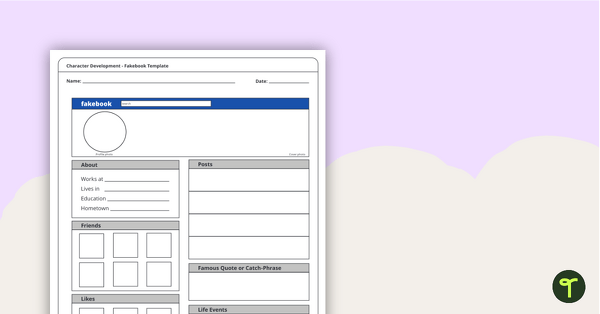
Character Development – Fakebook Page Worksheet
Use research and creative writing skills to design a social media profile for fiction or nonfiction persons.
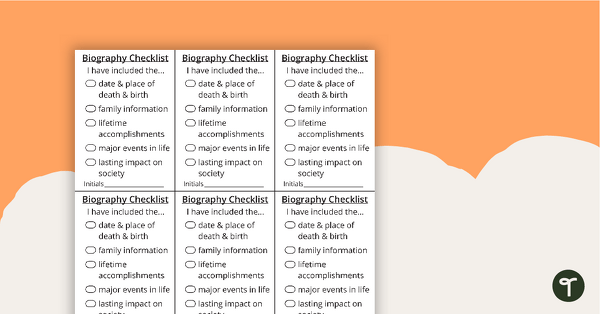
Biography Writing Checklist
Now your students can make sure that they have everything they need in their biography.
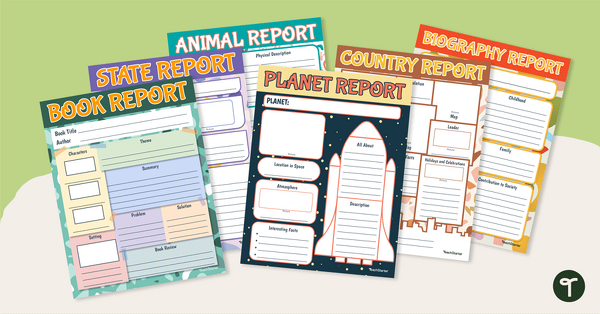
Let's Research! Digital and Print Poster Project Templates
Conduct, organize, and display research about books, people, planets, animals, states, and countries with a versatile set of printable and digital poster templates.
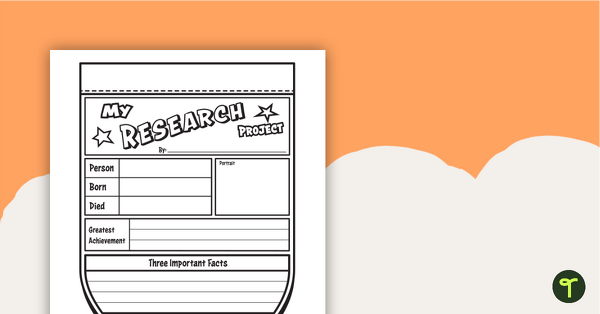
My Research Project - Pennant Banner
Create a pennant banner for students to record and display their biography research.
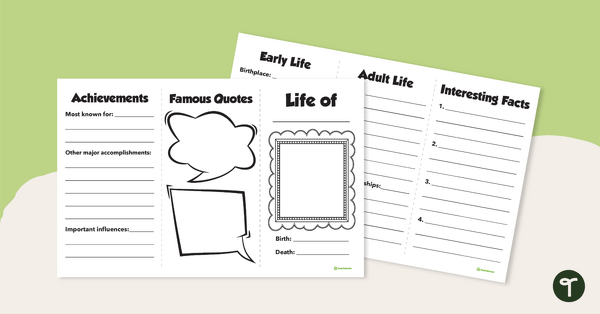
Biography Brochure Template
Help your students organize their thoughts about their biography subject.
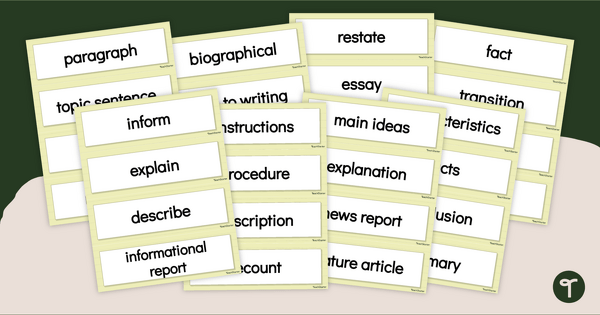
Informative Writing Word Wall
Display key vocabulary related to informative writing with a set of 48 word wall cards.
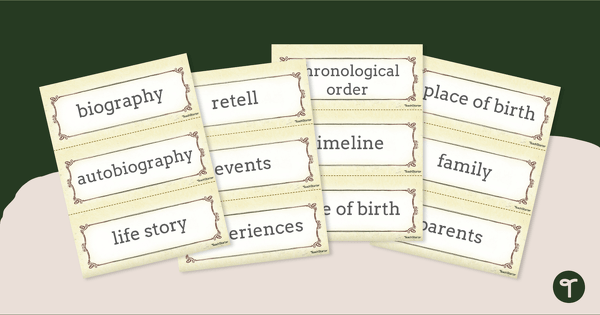

Biography Word Wall
A set of 30 vocabulary words related to biography writing.

Who is Amanda Gorman? Biography Research Template
Conduct and organize Amanda Gorman facts and research with a printable or digital flipbook activity.

Dr. Mae Jemison – Biography Structure Sorting Task
Read and sort to help students learn about the structure of a biography with our cut and paste biography worksheet.

Jane Addams Biography - Worksheet
Use this biographical constructed response worksheet to teach your students about Jane Addams.
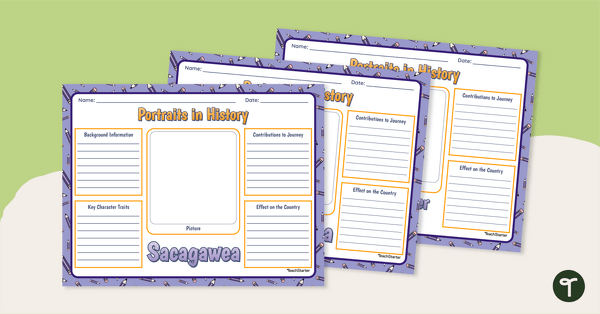
The Lewis and Clark Expedition - Interactive Research Templates
Use these three templates to record notes or research project content on the life and contributions of Meriwether Lewis, William Clark, and Sacagawea
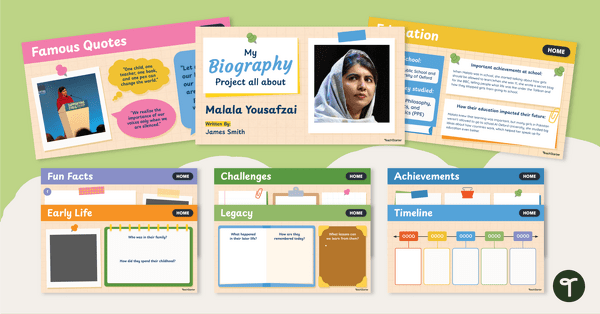
Writing a Biography Project
Use this PowerPoint template for students to author a researched-based biography on a historical figure.
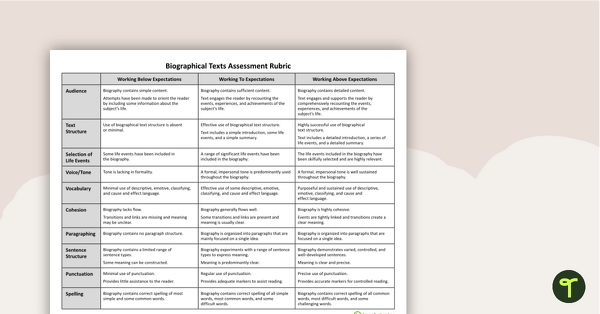
Assessment Rubric – Biographical Texts
An assessment rubric designed to help teachers to assess students’ biography writing.
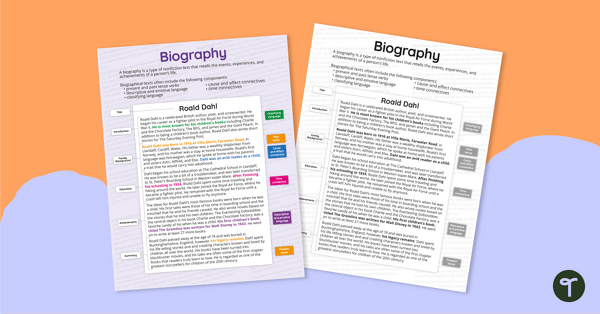
Elements of a Biography Poster
Use this biographical writing poster with annotations to help your students understand how to write an engaging biography.
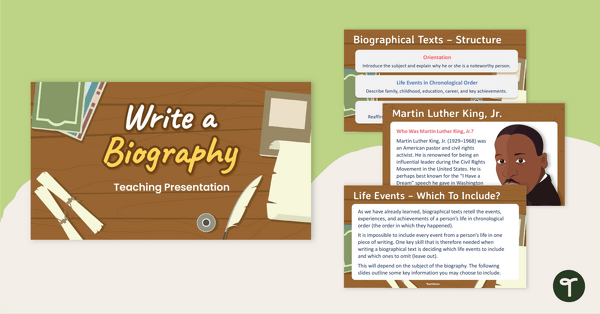
Writing Biographical Texts PowerPoint
A 29-slide, editable PowerPoint template to use when teaching older students about the structure and language features of biographical texts.
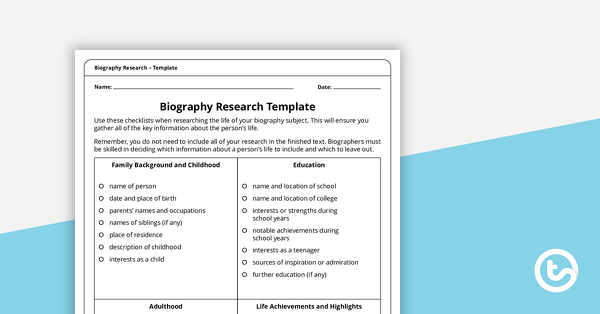
Biography Research Template
A research template for older students to use when writing a biography.
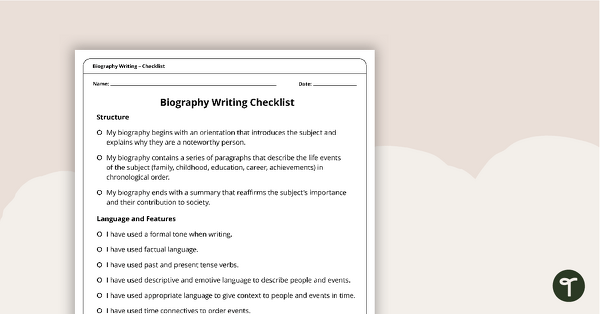
Biography Writing Checklist – Structure, Language, and Features
A checklist for students to use when proofreading and editing their biography writing.
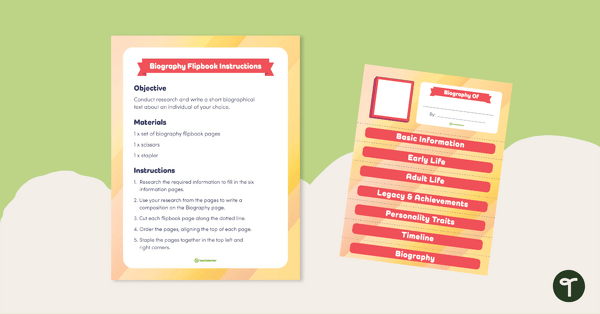
Biography Flipbook Template
Create a flipbook that clearly illustrates the most significant aspects of a biography subject.

Biography Writing Template
Guide students through the structure and elements included in biography writing.
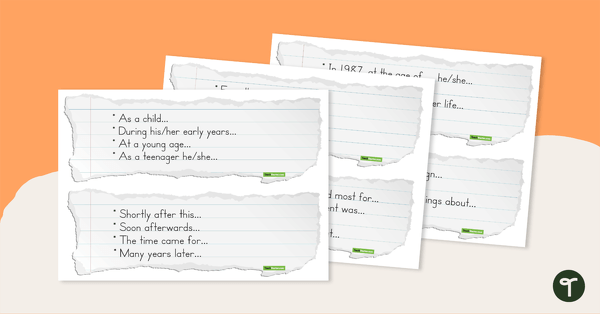
Biography Sentence Starters
Give students a jumpstart on writing about people with 24 sentence starters.
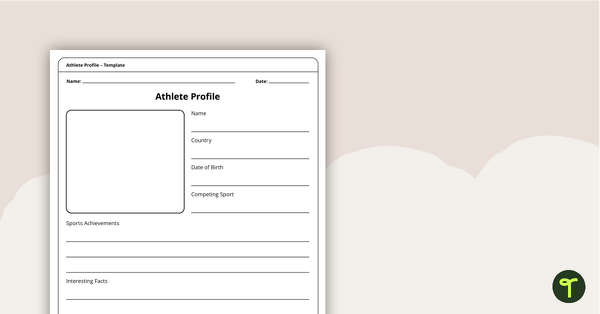
Athlete Profile Template
A worksheet to use in the classroom when writing athlete profiles.
- Biography Writing for 1st Grade
- Biography Writing for 2nd Grade
- Biography Writing for 3rd Grade
- Biography Writing for 4th Grade
- Biography Writing for 6th Grade
How to Write a Biography in 8 Steps (The Non-Boring Way!)
Compelling biographies help us better connect with others while fostering empathy and understanding. Discover the steps to write one that captivates your audience!
Subscribe to our weekly newsletter
Have you ever been captivated by someone’s life story? From the ancient tales of great conquerors to the modern accounts of influential figures, biographies have enchanted readers and viewers for centuries.
The stories of real people’s lives not only entertain and educate but also provide a unique window into the human experience. In fact, according to research 1 https://www.ncbi.nlm.nih.gov/pmc/articles/PMC8796048/ , human stories like biographies can help us better connect with others while fostering empathy and understanding.
In this article, let’s dive into how to write a compelling biography, from the research phase to delivery.
What Are the Key Elements of a Biography?
The key elements of a well-written biography bring characters to life. They include thorough research, relevant interviews, clear structure, captivating prose, compelling themes, and a balance between objectivity and empathy.
- Thorough research: Helps create an accurate portrayal of your subject
- Relevant interviews: Insights help provide a deeper understanding of your subject
- Clear structure: Helps you outline your ideas for a compelling narrative
- Captivating prose: Provides descriptive language to paint a picture of your subject
- Compelling themes: Showcases the motivations and desires behind your subject
- A balance between objectivity and empathy: Keeps biases in check and allows your subject to shine for who they are
As you develop your biography, remember that these stories hold an enduring appeal because they offer people an opportunity to explore the depths of the human psyche, unravel extraordinary accomplishments, and discover the vulnerabilities and triumphs of individuals who have left their mark on the world.
Here are the topics a biography typically covers:
- Early life and background : Provide context about the subject’s upbringing, family, and cultural influences.
- Achievements and milestones: Highlight notable accomplishments, contributions, and significant events throughout their life.
- Challenges and struggles: Explore the obstacles they faced, the lessons learned, and how they overcame adversity.
- Personal characteristics: Describe their personality traits, values, beliefs, and motivations that shaped their actions and decisions.
- Impact and legacy: Discuss the lasting influence and contributions of the subject, both during their lifetime and beyond.
Ready to start crafting your biography? Find greater success with this helpful goal-setting resource!
How To Set Better Goals Using Science
Do you set the same goals over and over again? If you’re not achieving your goals – it’s not your fault! Let me show you the science-based goal-setting framework to help you achieve your biggest goals.
Let’s look at the six key elements of a well-written biography more closely and the steps you can follow to develop your own.
How to Write a Biography in 8 Steps Using Key Elements
Choose your presentation format.
Presenting your biography can take on various forms, the most traditional being written form. The basis for this article assumes you’re writing a conventional biography; however, this foundation can also help you create a multimedia presentation or website as well.
Consider these various formats to present your biography:
- Traditional Written Biographies: This classic approach provides a comprehensive account of a person’s life through the written word. Traditional biographies can be published in print or ebooks , allowing readers to engage deeply with the subject’s story.
- Multimedia Presentations: In the digital age, multimedia presentations offer a dynamic way to present biographies. Incorporate audio, video, photographs, and interactive elements to enhance the audience’s experience.
- Online Platforms: Online platforms, such as blogs or dedicated biography websites, provide accessible avenues for sharing biographies. They allow for easy updates, reader engagement, and the incorporation of multimedia elements.
Choose your subject and conduct research
To create a vivid and accurate portrayal of a person’s life, conduct extensive research. Dive into archives, read letters, examine diaries, explore photographs, and immerse yourself in the historical and cultural context surrounding your subject. This will help you unearth the small details that breathe life into your biography.
Whether you’re writing a biography about a historical figure, contemporary icon, or everyday individual, you’ll want to consider the different factors to focus on. Here are some examples of three types of individuals and the kind of research that will be most helpful.
- Historical Figures: When writing about historical figures, immerse yourself in their era. Understand the social, political, and cultural forces that shaped their lives. I recommend visiting your local library and connecting with a research librarian for support. Otherwise, other tools for historical research include Google Scholar. Analyze primary sources and multiple perspectives to present a well-rounded account.
- Contemporary Icons: Biographies of modern icons offer a chance to delve into their ongoing impact. Conduct interviews or gather insights from their close associates to understand their present-day influence. Stay current with the latest developments, and be prepared to update your work as the subject’s story unfolds.
- Everyday Individuals: Biographies need not be reserved for the famous. Every day individuals possess stories that can be just as compelling. Uncover the extraordinary within the ordinary, highlighting the struggles, triumphs, and personal growth of individuals who might otherwise remain unsung.
- Yourself! Want to write a biography on yourself? Autobiographies are a great way to explore who you are. Get ready to do some serious self-reflection with the steps below.
Pro Tip: Compile your research digitally using helpful cloud filings systems like Google Drive , OneDrive , or Dropbox . Organize your files by category, including information about their youth, family, achievements, and life lessons. You may also choose to write down research references or collect paper clippings on note cards, categorizing your physical files of research along the way.
Develop compelling themes and motifs
Identify overarching themes or motifs that emerge from the subject’s life. These could be resilience, ambition, love, or societal change. Weave these elements into the narrative, highlighting their significance and impact on the person’s journey. Here are some examples:
- Overcoming Adversity: These biographies feature perseverance, resilience, and determination. Examples include Helen Keller, Nelson Mandela, and Malala Yousafzai.
- Pursuit of Excellence: These biographies highlight people who have worked tirelessly to achieve their goals. Examples include Steve Jobs, Serena Williams, and Michael Jordan.
- Quest for Knowledge: These biographies focus on the curiosity that led to significant contributions to our world. Examples include Albert Einstein, Marie Curie, and Charles Darwin.
- Personal Transformation: These biographies explore a change in beliefs, values, or priorities. Examples include Malcolm X, Oprah Winfrey, and Maya Angelou.
- Legacy and Impact: These biographies examine a body of work that made a lasting contribution to society. Examples include Martin Luther King Jr., Mother Teresa, and Mahatma Gandhi.
Conduct relevant interviews
Whenever possible, seek firsthand accounts from those who knew or interacted with the subject. Conduct interviews with family members, friends, colleagues, or experts in the field. Their insights and anecdotes can provide a deeper understanding of the person’s character and experiences.
When conducting interviews for a biography, consider the following tips to ensure a productive and insightful conversation:
- Familiarize yourself with the interviewee’s background and accomplishments.
- Develop a list of well-thought-out questions that cover key aspects of their lives and experiences, including questions about your subject’s youth, family, achievements, and life transitions or struggles.
- Begin the interview by establishing a comfortable and friendly atmosphere to put the interviewee at ease.
- Show genuine interest in their story and listen actively to their responses.
- Ask open-ended questions encouraging detailed and reflective responses.
- Avoid yes/no questions and ask for their insights, memories, and personal perspectives.
- Some topics you might consider for your questions include early life, achievements, challenges, motivations, values, relationships, lessons learned, and advice.
- Pay close attention to the interviewee’s answers, body language, and tone of voice.
- Ask follow-up questions to clarify or delve deeper into specific topics.
- Show empathy and understanding, creating a safe space for the interviewee to share personal or sensitive information.
- Remain flexible during the interview, allowing the conversation to flow naturally.
- Be prepared to deviate from your prepared questions if unexpected but relevant topics arise.
- Respect the interviewee’s boundaries and be mindful of any topics they may not wish to discuss.
- Take thorough and organized notes during the interview to capture important details.
- Consider recording the interview (with permission) to ensure accurate quotes and references.
- Ask for permission to follow up with additional questions or for clarification.
- Doing a biography on yourself? Ask yourself deep questions to harvest new stories and anecdotes.
Remember, the goal of the interview is to gather valuable information and personal perspectives that will contribute to the authenticity and depth of your biography. Approach the interview process with sensitivity, respect, and genuine curiosity about the interviewee’s life and experiences.
Develop a clear structure
Outline your biography, ensuring a logical and engaging narrative flow. Consider the chronological order, significant milestones, and turning points in the subject’s life. Organize your gathered information to capture the essence of their journey while maintaining a compelling rhythm throughout.
A good outline for a biography can vary depending on the specific subject and the desired structure of the narrative. However, here’s a general outline that can serve as a starting point:
A. Introduction
a) Hook or engaging opening to capture the reader’s attention
b) Background information (birthplace, date, family, etc.)
c) A brief overview of the subject’s significance or why they are worth exploring
B. Early Life and Background
a) Childhood and upbringing
b) Influences, such as family, education, or cultural factors
c) Formative experiences or events that shaped the subject’s character or interests
C. Major Achievements and Milestones
a) A chronological exploration of the subject’s notable accomplishments, contributions, or milestones
b) Focus on key moments or achievements that highlight their impact or significance.
c) Provide context and details to paint a vivid picture of their achievements
D. Challenges and Obstacles
a) Discussion of the challenges, setbacks, or adversities the subject encountered
b) How they overcame obstacles or grew through difficult experiences
c) Insights into their resilience, determination, or problem-solving abilities
E. Personal Life and Relationships
a) Exploration of the subject’s relationships, such as family, friends, or romantic partners
b) Insights into their personal joys, struggles, or transformative experiences
c) How their personal life intersected with their professional or public achievements
F. Legacy and Impact
a) Examination of the subject’s lasting influence, contributions, or impact on society
b) Discuss how their work or actions continue to resonate or shape the world today
c) Reflection on their legacy and the lessons we can learn from their life story
G. Conclusion
a) Summarize the key aspects of the subject’s life and their significance
b) Provide a final reflection or insight on their overall journey or impact
c) Leave the reader with a lasting impression or call to action
Pro Tip: Looking for help drafting an outline to get you started? Use free tools like ChatGPT to jumpstart your outline by putting in a prompt request like, “Write an outline for a biography about X, including any relevant details on the subject that should be included.”
Craft captivating prose
Employ descriptive language to transport readers into the subject’s world. Paint vivid portraits of their physical appearance, mannerisms, and surroundings. Use sensory details to evoke emotions and create a strong connection between the reader and the subject.
Here are some examples:
- “She was a force of nature, with a fierce determination and an unwavering commitment to justice.” (Ruth Bader Ginsburg)
- “His piercing blue eyes seemed to look right through you, and his voice had a commanding presence that demanded attention.” (Winston Churchill)
- “She moved with a grace and elegance that belied her inner strength and resilience.” (Audrey Hepburn)
- “His rugged features and piercing gaze made him a natural leading man, but it was his depth and vulnerability that set him apart.” (Marlon Brando)
- “She had a contagious energy and a magnetic personality that drew people to her like a moth to a flame.” (Princess Diana)
- “His quiet intensity and unwavering dedication to his craft made him one of the greatest artists of his time.” (Leonardo da Vinci)
Action Step: While writing descriptive prose takes some practice, it’s an art you can master with little creative writing skills. To help you write descriptive prose, practice closing your eyes and imagining your subject.
- What expression is on their face?
- How are they dressed?
- What does their body language express?
- How do they smell?
- How do they make you feel?
- How do they make others feel?
- What’s in their surroundings?
- What are they doing with their hands?
- What do you imagine they’re thinking about?
With questions like these, you’ll start to use descriptive language to bring your subject to life.
Build a balance of objectivity and empathy
Strive for an objective portrayal while infusing empathy and understanding into your writing. Remain aware of biases and preconceived notions, giving your subject the space to shine in their unique light.
To check yourself, filter your writing and interviewing with these tips:
- Verify Information: Cross-reference information from various sources to ensure accuracy. Use tools like Fact Check Explorer to fact-check claims, dates, and events to avoid errors or inaccuracies that could skew the narrative.
- Multiple Perspectives: Seek out different viewpoints on the subject. This includes interviewing or reaching out to people with significant interactions or relationships with the subject. Incorporating diverse perspectives can counterbalance biases and provide a broader understanding.
- Empathetic Listening: During interviews or conversations, practice active listening and empathize with the interviewee’s experiences and emotions. This allows you to understand the subject’s perspective and incorporate their insights and feelings into the narrative.
- Contextualize Emotions: When sharing the subject’s emotional experiences or personal struggles, provide sufficient context and background. This helps readers understand the motivations and circumstances behind their actions and allows for empathetic understanding without veering into excessive sentimentality.
- Credible Interpretation: While interpreting the subject’s thoughts, motives, or intentions, be clear about what is factual and what is speculative. Clearly distinguish between evidence-based information and your interpretations to maintain objectivity.
- Respect Boundaries: Be mindful of the subject’s privacy and any requests they may have regarding sensitive or personal information. Respecting their boundaries shows empathy and allows for a respectful portrayal while maintaining the necessary level of objectivity.
- Acknowledge Limitations: Recognize that achieving complete objectivity in a biography is challenging. Biases can inadvertently seep into the narrative. However, by being aware of your biases and consciously presenting a fair and balanced account, you can mitigate their influence.
Respect truth, privacy, and sensitivity
Remember, writing biographies carries ethical responsibilities. It’s important to maintain accuracy through credible research and gain consent while being sensitive to controversial or difficult topics. Here are some considerations:
- Accuracy: Maintain a commitment to truth and accuracy. Verify facts and corroborate information from multiple sources to ensure the reliability of your narrative. Cite your sources and be transparent about any uncertainties or gaps in knowledge.
- Privacy and Consent: Respect the privacy of living individuals mentioned in your biography. Seek consent when sharing personal details or sensitive information. Balance the subject’s right to privacy with the importance of honesty and transparency.
- Sensitivity: Approach sensitive or controversial topics with care and empathy. Consider the potential impact of your words on the subject’s loved ones or affected communities—present differing perspectives without sensationalism or bias.
Writing a Biography FAQs
The length of a biography can vary greatly, depending on the subject and the depth of exploration. Some biographies span a few hundred pages, while others extend to multiple volumes. Focus on capturing the subject’s life’s essence rather than strictly adhering to a predetermined length.
Some common mistakes to avoid when writing a biography include the following: Lack of thorough research or reliance on a single source. Inaccurate or misleading information. Excessive personal bias or projection onto the subject. Neglecting to verify facts or failing to cite sources. Poor organization or a disjointed narrative flow. Neglecting to balance objectivity with empathy. Overloading the biography with irrelevant details or digressions. Failing to respect privacy or ethical considerations.
While chronological order is commonly used in biographies, it is not required. Some biographers employ a thematic approach or explore specific periods or events in the subject’s life. Experiment with different structures to find the most engaging way to tell your subject’s story.
The purpose of writing a biography is to capture and share an individual’s life story. Biographies provide insights into a person’s experiences, achievements, and challenges, offering readers inspiration, knowledge, and understanding. They preserve the legacy of individuals, contribute to historical records, and celebrate the diversity of human lives.
When choosing a subject for your biography, consider someone who inspires you, interests you, or has significantly impacted society. It could be a historical figure, a contemporary icon, or even an everyday individual with a remarkable story. Choose a subject with sufficient available information, access to primary sources or interviews, and a narrative that resonates with you and potential readers.
Key elements to include in a biography are: Early life and background: Provide context about the subject’s upbringing, family, and cultural influences. Achievements and milestones: Highlight notable accomplishments, contributions, and significant events throughout their life. Challenges and struggles: Explore the obstacles they faced, the lessons learned, and how they overcame adversity. Personal characteristics: Describe their personality traits, values, beliefs, and motivations that shaped their actions and decisions. Impact and legacy: Discuss the lasting influence and contributions of the subject, both during their lifetime and beyond.
Including personal anecdotes can add depth and humanize the subject of your biography. However, be selective and ensure that the stories are relevant, contribute to understanding the person’s character or experiences, and align with the overall narrative. Balancing personal anecdotes with factual information is critical to maintaining accuracy and credibility.
Conducting research for a biography involves exploring a variety of sources. Start with primary sources such as personal papers, letters, journals, and interviews with the subject or people who knew them. Secondary sources such as books, articles, and academic papers provide additional context and perspectives. Online databases, archives, libraries, and museums are valuable resources for finding relevant information.
Consult a wide range of sources to ensure a comprehensive and accurate biography. Primary sources, such as personal documents, letters, diaries, and interviews, offer firsthand accounts and unique insights. Secondary sources provide broader context and analysis, including books, articles, scholarly works, and historical records. Remember to evaluate the credibility and reliability of your sources critically.
Organize the information in your biography logically and engagingly. Consider using a chronological structure, starting with the subject’s early life and progressing through significant events and milestones. Alternatively, adopt a thematic approach, grouping related information based on themes or significant aspects of their life. Use clear headings, subheadings, and transitions to guide readers through the narrative flow.
Writing Biographies Key Takeaways
In summary, take note of these ideas and tips before you start writing your biography:
- Biographies hold enduring appeal, offering a glimpse into the human experience across time.
- Thorough research, interviews, and captivating prose are essential for crafting compelling biographies.
- Ethical considerations, such as accuracy, privacy, and sensitivity, are crucial when writing about real people’s lives.
- Choose subjects that genuinely inspire and resonate with you.
- Immerse yourself in the subject’s world to understand their motivations and challenges.
- Develop strong research skills and utilize a wide range of sources.
- Craft a compelling narrative that engages readers from the very first page.
- Seek feedback from trusted sources to refine your writing and storytelling abilities.
- Continuously explore new biographies to broaden your understanding of different styles and approaches.
- Embrace the unique voice and perspective you bring to the storytelling process.
Writing a biography book? Check out this helpful article, How to Write a Book: 10 Questions to Ask Before You Start Writing !
Article sources
Popular guides, how to deal with difficult people at work.
Do you have a difficult boss? Colleague? Client? Learn how to transform your difficult relationship. I’ll show you my science-based approach to building a strong, productive relationship with even the most difficult people.
Related Articles
Science of People offers over 1000+ articles on people skills and nonverbal behavior.
Get our latest insights and advice delivered to your inbox.
It’s a privilege to be in your inbox. We promise only to send the good stuff.
How to Write an Interesting Biography
- Homework Tips
- Learning Styles & Skills
- Study Methods
- Time Management
- Private School
- College Admissions
- College Life
- Graduate School
- Business School
- Distance Learning
- M.Ed., Education Administration, University of Georgia
- B.A., History, Armstrong State University
A biography is a written account of the series of events that make up a person's life. Some of those events are going to be pretty boring, so you'll need to try to make your account as interesting as possible!
Every student will write a biography at some point, but the level of detail and sophistication will differ. A fourth grade biography will be much different from a middle school-level biography or a high school or college-level biography.
However, each biography will include the basic details. The first information you should gather in your research will include biographical details and facts. You must use a trustworthy resource to ensure that your information is accurate.
Using research note cards , collect the following data, carefully recording the source for each piece of information:
Including Basic Details
- Date and place of birth and death
- Family information
- Lifetime accomplishments
- Major events of life
- Effects/impact on society, historical significance
While this information is necessary to your project, these dry facts, on their own, don't really make a very good biography. Once you've found these basics, you'll want to dig a little deeper.
You choose a certain person because you think he or she is interesting, so you certainly don't want to burden your paper with an inventory of boring facts. Your goal is to impress your reader!
Start off with great first sentence . It's a good idea to begin with a really interesting statement, a little-known fact, or really intriguing event.
You should avoid starting out with a standard but boring line like:
"Meriwether Lewis was born in Virginia in 1774."
Instead, try starting with something like this:
"Late one afternoon in October, 1809, Meriwether Lewis arrived at a small log cabin nestled deep in the Tennessee Mountains. By sunrise on the following day, he was dead, having suffered gunshot wounds to the head and chest.
You'll have to make sure your beginning is motivating, but it should also be relevant. The next sentence or two should lead into your thesis statement , or main message of your biography.
"It was a tragic end to a life that had so deeply affected the course of history in the United States. Meriwether Lewis, a driven and often tormented soul, led an expedition of discovery that expanded a young nation's economic potential, increased its scientific understanding, and enhanced its worldwide reputation."
Now that you've created an impressive beginning , you'll want to continue the flow. Find more intriguing details about the man and his work, and weave them into the composition.
Examples of Interesting Details:
- Some people believed that Lewis and Clark would encounter elephants in the western wilderness, having misunderstood the wooly mammoth bones discovered in the United States.
- The expedition resulted in the discovery and description of 122 new animal species and subspecies.
- Lewis was a hypochondriac.
- His death is still an unsolved mystery, although it was ruled a suicide.
You can find interesting facts by consulting diverse sources.
Fill the body of your biography with material that gives insight into your subject's personality. For instance, in a biography about Meriwether Lewis, you would ask what traits or events motivated him to embark on such a monumental exercise.
Questions to Consider in Your Biography:
- Was there something in your subject's childhood that shaped his/her personality?
- Was there a personality trait that drove him/her to succeed or impeded his progress?
- What adjectives would you use to describe him/her?
- What were some turning points in this life?
- What was his/her impact on history?
Be sure to use transitional phrases and words to link your paragraphs and make your composition paragraphs flow . It is normal for good writers to re-arrange their sentences to create a better paper.
The final paragraph will summarize your main points and re-assert your main claim about your subject. It should point out your main points, re-name the person you're writing about, but it should not repeat specific examples.
As always, proofread your paper and check for errors. Create a bibliography and title page according to your teacher's instructions. Consult a style guide for proper documentation.
- Famous People for Biography Topics
- How to Design a Book Cover
- How to Help Your 4th Grader Write a Biography
- Character Traits: Ideas for Your Short Story
- 5 Tips on How to Write a Speech Essay
- 10 Tips for the SAT Essay
- Writing a Paper about an Environmental Issue
- Writing the Parts of a Stage Play Script
- How to Use Libraries and Archives for Research
- Questions to Ask a College Representative
- How to Write a Graduation Speech as Valedictorian
- Tips to Write a Great Letter to the Editor
- How to Write a Film Review
- How to Write and Structure a Persuasive Speech
- 18 Ways to Practice Spelling Words
- How to Give an Impromptu Speech
5th grade Biography Unit
Please log in to save materials. Log in
- EPUB 3 Student View
- PDF Student View
- Thin Common Cartridge
- Thin Common Cartridge Student View
- SCORM Package
- SCORM Package Student View
- 1 - Summary
- 2 - Background for Teachers
- 3 - Step 1 - Goals and Outcomes
- 4 - Step 2 - Planning Instruction
- 5 - Step 3 - Instruction
- 6 - Step 4 - Assessments
- View all as one page

Students will be writing a biography in an in person lesson that requires them to learn and understand steps of a biography, publish a written copy, and publish a pages document on their ipads.
Background for Teachers
To teach this lesson you will need an understanding of the 5th grade writing process as well as what needs to be taught to teach biography writing. You will also need a basic understanding of how to use pages.
Step 1 - Goals and Outcomes
Students will be able to write a 5 paragraph biography and present the life story of someone of their choice to the class using Pages on the ipad. They will be able to introduce a topic clearly, provide a general observation and focus, and group related information logically.
Writing Standard 2
Write informative/explanatory texts to examine a topic and convey ideas and information clearly.
Introduce a topic clearly, provide a general observation and focus, and group related information logically; include formatting (e.g., headings), illustrations, and multimedia when useful to aiding comprehension.
Develop the topic with facts, definitions, concrete details, quotations, or other information and examples related to the topic.
Link ideas within and across categories of information using words, phrases, and clauses (e.g., in contrast, especially).
Use precise language and domain-specific vocabulary to inform about or explain the topic.
Provide a concluding statement or section related to the information or explanation presented.
Writing Standard 6
With some guidance and support from adults, use technology, including the Internet, to produce and publish writing as well as to interact and collaborate with others; demonstrate sufficient command of keyboarding skills to type a minimum of two pages in a single sitting.
Step 2 - Planning Instruction
Ask the class, “Has anyone ever inspired you before? Who was it and why were they inspiring?” Make a list on the board and discuss the common traits these people had that were inspiring. Then ask, “Has anyone famous, or in history inspired you?” Using this website as an indoruction www.biography.com pick a few bio’s to summarize or read to your class. Next, tell them their assignment will be to do a biography report.
Gather biography books from your school library of various people in history, pop culture, sports, or other people you think your students might be interested in researching. Show your students the books and allow them to choose the person they want to write their biography about. You could also have them choose a person before your class library time and then have them select a book when they go to the library.
Provide a list of important people in history for your students in case they are struggling to think of someone.
Step 3 - Instruction
Websites: biographyonline.net and biography.com have great resources for this lesson
Using the website and books allow students to do research and gather information using a graphic organizers. Fill one out as an example in front of your class. Once their information is gathered they can begin their essay outline.
Information to look for while brainstorming:
Date of Birth:
Where were they born:
Date of Death:
Early life and history:
Why this person is famous:
Interesting facts:
Major Accomplishments:
Quote from the person:
How has this person inspired you?
Once students have researched and brainstormed the answer to these questions they may begin writing their biography report. Each report should include an introduction, 3 body paragraphs, and a closing. Model each step with a person you have chosen to show students exactly what is expected and help students who may be struggling. If any students need accommodations you could have them do the same person you are doing.
Introduction: Introduce your topic, and the information that will be discussed in your body paragraphs. Start with a short story, questions, fact, quote, or interesting statement about your person.
Body Paragraphs: Each body paragraph should highlight information mentioned in your introduction as well as the facts you have gathered. This is also where you can include paragraph heading, charts, graphs, and tables.
Conclusion: Wrap up your statements and thoughts here. Reemphasize important key points in a new and fresh way.
Creating a Page on the iPad:
Students will use ipads to gather pictures of the person they chose to write about. They will then use the pages app on the iPad to create an informational sheet to share with the class. The page must include pictures, the person's name you wrote about, date of birth, date of death (if applicable), what makes them famous, a few interesting facts, a quote from the famous person, and a blurb on why this person inspired you.
When students are finished with their page they will find a partner to collaborate with. Using the collaboration button in the app students will send their page to a partner. They will need to find 3 compliments they can give about their page and at least one suggestion. There might be more than one suggestion but students need to look for 3 things to say they did well and at least 1 thing they could change or improve. Watch for spelling errors or punctuation errors.
Once all students are done they will present their page to the class. It is fun to suggest that students dress up as their famous person when they present.
Step 4 - Assessments
Attached is a Rubric for the students 5 paragraph biography as well as the Rubric for their Pages presentation. Part of their assessment will also be presenting to the class. This is attached to the media presentation rubric.
Pages Presentation for Biography Name:
| Student created Pages presentation in the iPad that aligned with their biography. | /1 |
| Student presented to the class. | /5 |
| Student used creativity and expression in their presentation. | /1 |
| Students’ work was free of typing, grammatical, and spelling errors. | /1 |
| The page includes pictures. | /1 |
| The name of the famous person is clearly posted. | /1 |
| Important dates are listed: birth, death, etc | /1 |
| We know why they are famous. | /1 |
| Interesting facts are shared. | /1 |
| Quote | /1 |
| Why did they inspire you? | /1 |
| Total: | /15 |
Attached Resources
Biography:autobiography Rubric
File size 261.5 KB

Biography Worksheets for Grades K-5

| Add to Folder | |
|---|---|
| creative writing | |
| children's book | |
| activities | |
| classroom tools | |
| language arts and writing | |
| vocabulary |
- Nelson Mandela Biography: A Reading Warm-Up
- Helen Keller Biography: A Reading Warm-Up
- Walt Disney Biography: A Nonfiction Reading Warm-Up
- Harriet Tubman and the Underground Railroad
- Helen Keller
- Getting to Know Me
- Learn About Susan B. Anthony
- Benjamin Franklin Little Book
- Abraham Lincoln Biography & Mini-Book
- Betsy Ross Little Book
- Babe Ruth Reading Warm-Up: Biography
- Learn About Paul Revere
- We Beat the Street Discussion Guide
- Albert Einstein Biography: A Reading Warm-Up
- Albert Einstein, Physicist
- Betsy Ross Biography: Reading Warm-Up for Grades 1 & 2
- Martin Luther King Jr Coloring Page
- Learn About Johnny Appleseed
- Thomas Alva Edison, Inventor
- My Book About George Washington
- George Washington Biography: A Reading Warm-Up
- Garrett Morgan Coloring Page
- George Washington Carver – Coloring Page
- The Washington Monument
- My Book About Martin Luther King, Jr.
- The Life and Accomplishments of Martin Luther King Jr.
- Daniel Boone Biography: A Reading Warm-Up
- Science and Social Studies: Benjamin Franklin
- Bio of a Famous Scientist
- More Biography Printables, Grades K-5
Featured 5th Grade Resources
Related Resources
About the author.

TeacherVision Editorial Staff
The TeacherVision editorial team is comprised of teachers, experts, and content professionals dedicated to bringing you the most accurate and relevant information in the teaching space.

- International
- Education Jobs
- Schools directory
- Resources Education Jobs Schools directory News Search

Year 5: Biographies and Autobiographies (Week 1 of 2)
Subject: English
Age range: 7-11
Resource type: Unit of work
Last updated
10 November 2019
- Share through email
- Share through twitter
- Share through linkedin
- Share through facebook
- Share through pinterest

This bundle includes 5 complete lesson plans, resources and an interactive PowerPoint to support the learning of Biographies and Autobiographies. This week, children will focus mainly on biographies. They will learn to read and identify the features of a biographical text before applying these when asked to write a biography about another member of the class during lesson 5! SPAG/GPS covered this week: prefixes, suffixes and sentence types (simple, compound and complex). Download Week 2 here !
Lesson 1: To read, compare and identify the features of a biography Lesson 2: To rewrite a biography extract using dialogue Lesson 3: To investigate suffixes Lesson 4: To investigate sentence structure in formal writing Lesson 5: To write a biography
Total Number of Slides: 32 Lesson Plans Included? Yes Resources Included? Yes #stressfreeteaching_dreamscheme
Creative Commons "Sharealike"
Your rating is required to reflect your happiness.
It's good to leave some feedback.
Something went wrong, please try again later.
fatemehhoushang
Empty reply does not make any sense for the end user
KayleighHouse
Really helpful resource thank you. Set out well and easy to follow.
Super helpful
Report this resource to let us know if it violates our terms and conditions. Our customer service team will review your report and will be in touch.
Not quite what you were looking for? Search by keyword to find the right resource:
Biography about a person
Loading ad...
- Google Classroom
- Microsoft Teams
- Download PDF
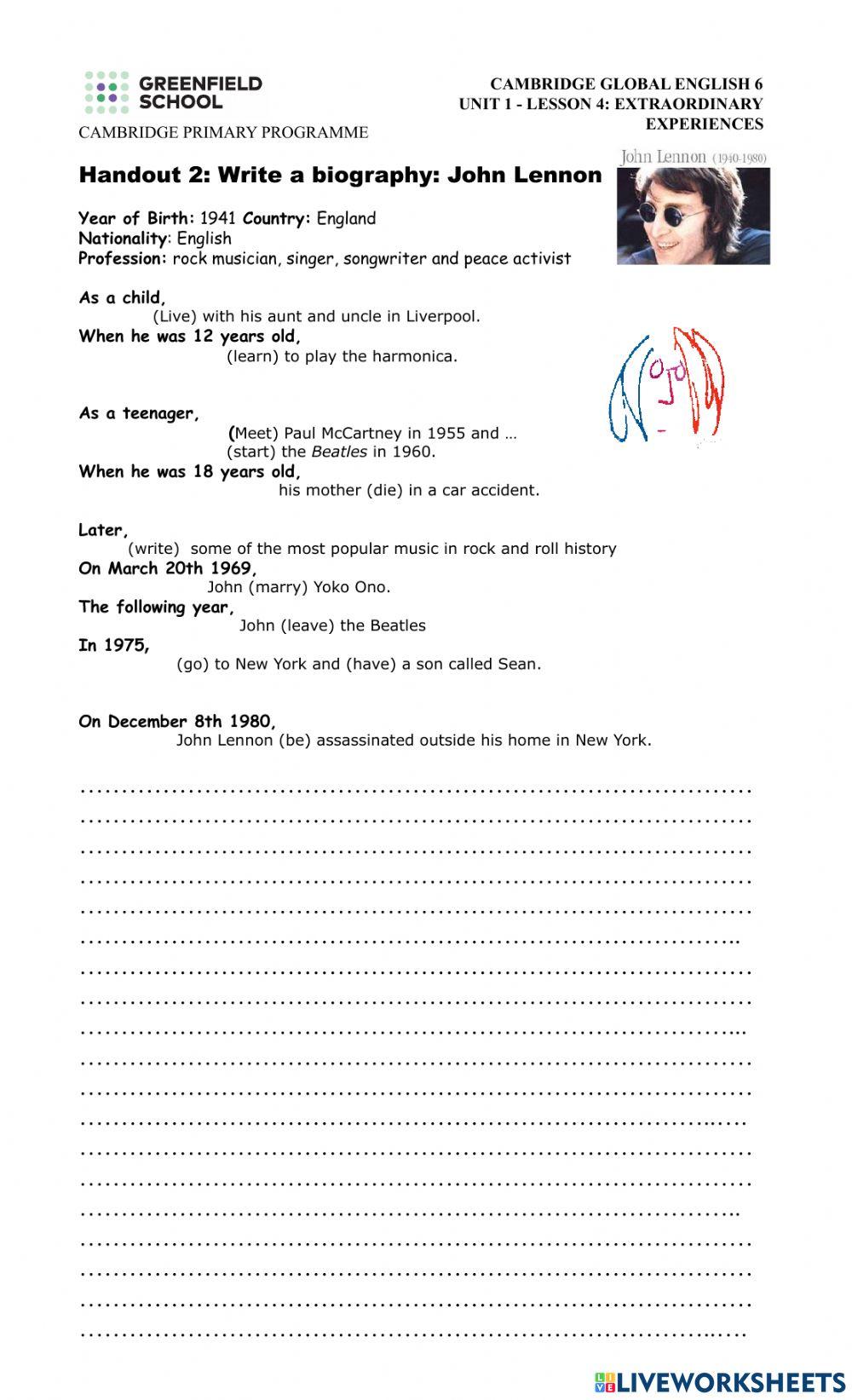
Protect your data
This site uses cookies and related technologies for site operation, and analytics as described in our Privacy Policy . You may choose to consent to our use of these technologies, reject non-essential technologies, or further manage your preferences.
- Resume and Cover Letter
- How to Write a Short Bio?...
How to Write a Short Bio? (With Examples)
7 min read · Updated on August 28, 2024

A short professional biography is a great tool to have in your career marketing toolkit.
As you progress through your career, there will likely come a time when someone wants you to provide them with a professional biography. It could be that your boss wants to include something on the team page of the company website or perhaps you need to write a blurb about your biggest achievements for a social media page.
Regardless of the reason, you should always have one ready to go. Many people have quite a few questions about writing short professional bios, though, including
What is a bio?
How to write a short bio?
What voice to use in a short bio – first person or third person?
What is the format of a short biography?
What is a good bio example?
Let's just say that you're in the right place to find out.
What is a short bio?
Have you ever heard the phrase “elevator pitch?” Well, that's what a bio is. It's about 200 words that define who you are, what you do, what you've accomplished, and what your goals are. If that seems like a lot to put into a couple hundred words, you're right.
This isn't the time to go on and on about everything you've ever done. Since the purpose of a short professional bio is to introduce you to whoever is reading it, it's best to worry about only hitting the high notes.
Think about what you say when someone asks you the following:
What do you do?
How long have you done it?
What do you like most about it?
Have you ever won an award ?
Why do you want to keep doing what you do?
Your answers to those questions will help you craft your biography, though you'll probably have to pare down the wording to keep it within the requisite word count. Always remember KISS – Keep it Short and Simple.
How to write a short professional bio?
Just like with your resume, a short professional bio should contain key details. Those details should also appear in a predictable order.
Your name and current job title
Your professional philosophy
Some of your best skills
Career achievements
What you have your sights set on for the future
You could also include things like links to online portfolios or your contact information, depending on where the bio is going to be used. For example, if you're adding the short professional bio to a web page that already has your contact info, then you don't need to add it to the bio itself.
First-person vs third-person for your short professional bio
Before you start writing, you have to decide which voice you're going to use for your biography. Meaning, are you going to write it using first-person or third-person?
First-person writing involves using pronouns like “I,” “me,” and “my”
Third-person writing is when you avoid using personal pronouns and stick to possessive pronouns or possessive adjectives like "he," "she," "his," and "her"
It all depends on your audience. You'd choose to write your short professional bio in the first person if you're using it for personal websites, social media profiles , and networking events. It's better to use the third person when you're writing for company websites, professional directories, or other formal settings.
Short professional bio examples: Your name and current job title
This may seem like a given, but because it's such a simple thing, a lot of people try to overdo it. You literally only need to write something like this
Third-person: Janet Plunder is the Head of Marketing for We Are Creatives, Inc.
First-person: My name is Jeff Safeport, and I am the Network Manager for BitBytes.
Short professional bio examples: Your professional philosophy
Have you ever thought about the values and ethics you possess and how those shape your work and interaction with others? That is the basis of your professional philosophy. Prospective employers and future clients want to know how you distinguish yourself from others. The way you come up with your professional philosophy is through a little self-assessment. Ask yourself
What do I believe in?
What am I committed to?
What values are most important in my professional life?
How do I approach challenges?
Have I made any type of impact in my field?
This is what the philosophy statement could look like in your short bio:
- Third-person: She is known for leading with integrity, fostering collaborative environments, and continuously seeking innovative solutions that drive success.
- First-person: I am committed to prioritizing client satisfaction. Also, by embracing the idea of lifelong learning, I consistently strive for excellence in everything all projects I undertake.
Short professional bio examples: Your skills and qualifications
Going back to the concept of KISS, you want to avoid trying to include a laundry list of every skill you possess. The idea here is to focus on the abilities that set you apart in your field. You need to be specific not only about what you excel at but also how the particular skills you choose for your short professional bio have helped you be successful.
For example:
- Third-person: Jane is known for creating digital marketing strategies, with a particular focus on SEO and content marketing. She has a proven track record of increasing online visibility, brand awareness, and consumer engagement for countless globally branded companies.
- First-person : One of my strong suits is the ability to streamline processes in a way that improves productivity across international teams. I do this through full lifecycle project management and deep-dive data analysis.
Short professional bio examples: Your career achievements
Back when you were writing your resume, you probably heard over and over again how important career achievements are. There are millions of articles out there that tell you how to quantify the things you've accomplished in past jobs because that's how prospective employers know you'll be a benefit to their team.
The same holds true for your short professional bio. Your readers will be able to tell how you can help them by getting a glimpse into your career wins. Focus on notable awards and major projects that point to you achieving milestones.
Here's what that could look like:
- Third-person: Recently, she led a rebranding project that increased revenue by more than 20%, earning her the Innovator of the Year award.
- First-person : In my last position, I ascended to the prestigious President's Club after overhauling project processes and saving the company $10M.
Short professional bio examples: Your professional goals
The one thing that distinguishes a short professional bio from your other career marketing documents is that it not only showcases your history but it's also future-facing. This gives you a great opportunity to talk about your aspirations and which direction you are heading in your career.
You can show prospective employers and future clients that you're going to be around a while by talking about things like being “forward-thinking” and emphasizing your “commitment to growth,” as examples.
Here are a couple of short professional bio examples you can use as inspiration for your own professional goals :
- Third-person: Jane is looking forward to developing leadership skills to transition into an executive management role so that she can foster innovation at the corporate level.
- First-person : Since the beginning of my career, I've focused on expanding my expertise in cybersecurity and am poised to move into a Chief Information Officer position.
Leave a lasting impression
No matter what type of document you're writing for your career, the object is always to leave a lasting impression. That holds true even for a short professional bio. It may only be a couple hundred words, but they're very important words. Keep it concise, relevant, and engaging, and the right doors will open to propel you along your career journey.
The best way to get the right details into your short professional bio is to use information from your resume. Does your resume say what you need it to say about your skills, qualifications, and achievements? Upload it for a free review and find out.
Recommended reading:
20 Funny and Awkward Zoom Fails: Meetings Gone Wrong
10 Things Every Job Seeker Should Know Before Starting Their Search
Why the Handshake May Go Away — and Options to Replace It
Related Articles:
7 Best Personal Skills for Your Resume (With Examples)
Great Jobs for Teens: Top Picks for 16-Year-Olds
Functional Resume: Writing Guide, Examples, & Template
See how your resume stacks up.
Career Advice Newsletter
Our experts gather the best career & resume tips weekly. Delivered weekly, always free.
Thanks! Career advice is on its way.
Share this article:
Let's stay in touch.
Subscribe today to get job tips and career advice that will come in handy.
Your information is secure. Please read our privacy policy for more information.

IMAGES
VIDEO
COMMENTS
This video is for children or teachers who are working with kids to help them write a biography of someone they have researched.
Master the skill of biography writing with our comprehensive guide. Learn how to write a biography, bios, access examples, and classroom resources.
MAIN BODY OF BIOGRAPHY. Using your previous knowledge from your solo talk, or the fact sheets, choose the most important events in their life to write about. You can talk about their childhood if you wish. First Level - Choose 3-4 key events. Second Level - Choose 5-6 key events. Write down your chosen key events on your planning sheet.
Writing a biography? The purpose, prompt, criteria for writing, and Common Core aligned standards based rubric available for teachers in grades 7-12.
Writing a biography can be a fun challenge, where you are sharing the story of someone's life with readers. You may need to write a biography for a class or decide to write one as a personal project. Once you have identified the subject of the biography, do your research so you know as much about them as possible. Then, dive into the writing of the biography and revising it until it is at ...
In this lesson plan for grades 1-5, students will use BrainPOP resources to learn about biographies and write their own biography on a selected person.
A biography is a detailed description of someone's life written by someone else. Writing a biography is a great way to get students to practise their reading and writing skills. Download FREE teacher-made resources covering 'Biography' View FREE Resources
The first step in teaching how to write a biography is explaining what a biography is by providing an example of one. This free Evan-Moor "Writing A Biography" lesson from Nonfiction Writing grade two includes guided instruction and practice activities to help students understand the important elements in a biography.
Biography Writing Teaching Resources for 5th Grade. A collection of resources to use when teaching your students about the biography text type. Resources include planning templates, checklists, writing...
Summary Students will be writing a biography in an in person lesson that requires them to learn and understand steps of a biography, publish a written copy, and publish a pages document on their ipads.
Creating a biography lesson plan for 5th grade can be both fun and educational. This guide will help teachers develop an engaging lesson plan that meets educational standards while keeping students…
Donald Trump. This biography details the 45th President of the United States' life, including his father's success in real estate, his three marriages, and his journey to becoming president. This biography can be used for your social studies lessons or simply to educate your children about the current president.
Biographies are how we learn information about another human being's life. Whether you want to start writing a biography about a famous person, historical figure, or an influential family member, it's important to know all the elements that make a biography worth both writing and reading.
Compelling biographies help us better connect with others while fostering empathy and understanding. Discover the steps to write one!
Learn how to write a biography that intrigues readers using these tips and examples.
This handy teacher-made guide to writing a biography is a great resource to help children get writing! Designed as a simple checklist for children to use.
Every student will write a biography at some point, but the level of detail and sophistication will differ. A fourth grade biography will be much different from a middle school-level biography or a high school or college-level biography.
Summary Students will be writing a biography in an in person lesson that requires them to learn and understand steps of a biography, publish a written copy, and publish a pages document on their ipads.
Biography Worksheets for Grades K-5. Introduce your students to the lives of famous and notable individuals with our biography printables. These resources, activities, and lesson plans are sure to interest your students in the study of biographies. They can follow the lives of many interesting people, including presidents, suffragists, and ...
Become a budding biographer with this biography writing examples set. This teacher-made resource has fantastic famous stories and is perfect for Year 5-6 kids.
Our fifth grade class will write a biography paper and give a speech on a person of their choosing. In our class, each student must choose a historical figure (President, inventor, leader, etc.) from U.S. history to research for their paper and speech. Both the speech and the paper, which will be in the form of a five paragraph Expository Essay, will be graded. Although some time will be ...
This bundle includes 5 complete lesson plans, resources and an interactive PowerPoint to support the learning of Biographies and Autobiographies. This week, children will focus mainly on biographies.
Liveworksheets transforms your traditional printable worksheets into self-correcting interactive exercises that the students can do online and send to the teacher.
You'd choose to write your short professional bio in the first person if you're using it for personal websites, social media profiles, and networking events. It's better to use the third person when you're writing for company websites, professional directories, or other formal settings.